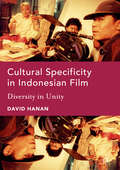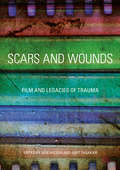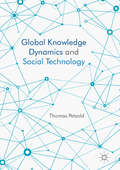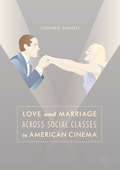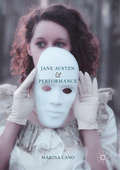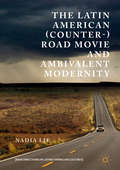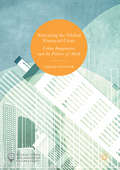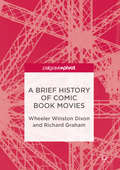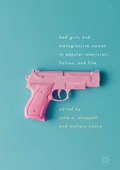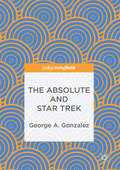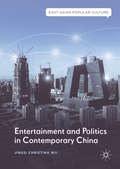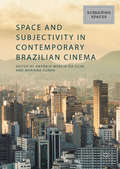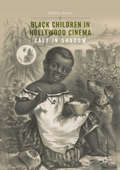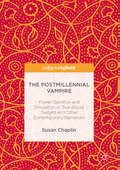- Table View
- List View
Cultural Specificity in Indonesian Film: Diversity in Unity
by David HananThis book explores ways in which diverse regional cultures in Indonesia and their histories have been expressed in film since the early 1950s. It also explores underlying cultural dominants within the new nation, established at the end of 1949 with the achievement of independence from Dutch colonialism. It sees these dominants—for example forms of group body language and forms of consultation—not simply as a product of the nation, but as related to unique and long standing formations and traditions in the numerous societies in the Indonesian archipelago, on which the nation is based. Nevertheless, the book is not concerned only with past traditions, but explores ways in which Indonesian filmmakers have addressed, critically, distinctive aspects of their traditional societies in their feature films (including at times the social position of women), linking past to the present, where relevant, in dynamic ways.
Scars and Wounds: Film and Legacies of Trauma
by Nick Hodgin Amit ThakkarThis book examines recent cinematic representations of the traumatic legacies of national and international events and processes. Whilst not ignoring European and Hollywood cinema, it includes studies of films about countries which have been less well-represented in cinematic trauma studies, including Australia, Rwanda, Chile and Iran. Each essay establishes national and international contexts that are relevant to the films considered. All essays also deal with form, whether this means the use of specific techniques to represent certain aspects of trauma or challenges to certain genre conventions to make them more adaptable to the traumatic legacies addressed by directors. The editors argue that the healing processes associated with such legacies can helpfully be studied through the idiom of ‘scar-formation’ rather than event-centred ‘wound-creation’.
Scars and Wounds: Film and Legacies of Trauma
by Nick Hodgin Amit ThakkarThis book examines recent cinematic representations of the traumatic legacies of national and international events and processes. Whilst not ignoring European and Hollywood cinema, it includes studies of films about countries which have been less well-represented in cinematic trauma studies, including Australia, Rwanda, Chile and Iran. Each essay establishes national and international contexts that are relevant to the films considered. All essays also deal with form, whether this means the use of specific techniques to represent certain aspects of trauma or challenges to certain genre conventions to make them more adaptable to the traumatic legacies addressed by directors. The editors argue that the healing processes associated with such legacies can helpfully be studied through the idiom of ‘scar-formation’ rather than event-centred ‘wound-creation’.
Global Knowledge Dynamics and Social Technology
by Thomas PetzoldThis volume unpacks an intriguing challenge for the field of media research: combining media research with the study of complex networks. Bringing together research on the small-world idea and digital culture it questions the assumption that we are separated from any other person on the planet by just a few steps, and that this distance decreases within digital social networks. The book argues that the role of languages is decisive to understand how people connect, and it looks at the consequences this has on the ways knowledge spreads digitally. This volume offers a first conceptual venue to analyse emerging phenomena at the innovative intersection of media and complex network research.
Global Knowledge Dynamics and Social Technology
by Thomas PetzoldThis volume unpacks an intriguing challenge for the field of media research: combining media research with the study of complex networks. Bringing together research on the small-world idea and digital culture it questions the assumption that we are separated from any other person on the planet by just a few steps, and that this distance decreases within digital social networks. The book argues that the role of languages is decisive to understand how people connect, and it looks at the consequences this has on the ways knowledge spreads digitally. This volume offers a first conceptual venue to analyse emerging phenomena at the innovative intersection of media and complex network research.
Love and Marriage Across Social Classes in American Cinema
by Stephen SharotThis book is the first comprehensive and systematic study of cross-class romance films throughout the history of American cinema. It provides vivid discussions of these romantic films, analyses their normative patterns and thematic concerns, traces how they were shaped by inequalities of gender and class in American society, and explains why they were especially popular from World War I through the roaring twenties and the Great Depression. In the vast majority of cross-class romance films the female is poor or from the working class, the male is wealthy or from the upper class, and the romance ends successfully in marriage or the promise of marriage.
Love and Marriage Across Social Classes in American Cinema
by Stephen SharotThis book is the first comprehensive and systematic study of cross-class romance films throughout the history of American cinema. It provides vivid discussions of these romantic films, analyses their normative patterns and thematic concerns, traces how they were shaped by inequalities of gender and class in American society, and explains why they were especially popular from World War I through the roaring twenties and the Great Depression. In the vast majority of cross-class romance films the female is poor or from the working class, the male is wealthy or from the upper class, and the romance ends successfully in marriage or the promise of marriage.
Jane Austen and Performance
by Marina CanoThis is the first exploration of the performative and theatrical force of Austen’s work and its afterlife, from the nineteenth century to the present. It unearths new and little-known Austen materials: from suffragette novels and pageants to school and amateur theatricals, passing through mid-twentieth-century representations in Scotland and America. The book concludes with an examination of Austen fandom based on an online survey conducted by the author, which elicited over 300 responses from fans across the globe. Through the lens of performative theory, this volume explores how Austen, her work and its afterlives, have aided the formation of collective and personal identity; how they have helped bring people together across the generations; and how they have had key psychological, pedagogical and therapeutic functions for an ever growing audience. Ultimately, this book explains why Austen remains the most beloved author in English Literature.
Jane Austen and Performance
by Marina CanoThis is the first exploration of the performative and theatrical force of Austen’s work and its afterlife, from the nineteenth century to the present. It unearths new and little-known Austen materials: from suffragette novels and pageants to school and amateur theatricals, passing through mid-twentieth-century representations in Scotland and America. The book concludes with an examination of Austen fandom based on an online survey conducted by the author, which elicited over 300 responses from fans across the globe. Through the lens of performative theory, this volume explores how Austen, her work and its afterlives, have aided the formation of collective and personal identity; how they have helped bring people together across the generations; and how they have had key psychological, pedagogical and therapeutic functions for an ever growing audience. Ultimately, this book explains why Austen remains the most beloved author in English Literature.
The Latin American (Counter-) Road Movie and Ambivalent Modernity
by Nadia LieThis book offers a comprehensive and systematic overview of the flourishing genre of the contemporary Latin American road movie, of which Diarios de motocicleta and Y tu mamá también are only the best-known examples. It offers the first systematic survey of the genre and explains why the road movie is key to contemporary Latin American cinema and society. Proposing the new category of “counter-road movie,” and paying special attention to the genre’s intricate relationship to modernity, Nadia Lie charts the variety of the road movie through films by both renowned and emerging filmmakers. The Latin American (Counter-) Road Movie and Ambivalent Modernity engages with ongoing debates on transnationalism and takes the reader along a wide range of topics, from exile to undocumented migration, from tourism to internally displaced people.
The Latin American (Counter-) Road Movie and Ambivalent Modernity
by Nadia LieThis book offers a comprehensive and systematic overview of the flourishing genre of the contemporary Latin American road movie, of which Diarios de motocicleta and Y tu mamá también are only the best-known examples. It offers the first systematic survey of the genre and explains why the road movie is key to contemporary Latin American cinema and society. Proposing the new category of “counter-road movie,” and paying special attention to the genre’s intricate relationship to modernity, Nadia Lie charts the variety of the road movie through films by both renowned and emerging filmmakers. The Latin American (Counter-) Road Movie and Ambivalent Modernity engages with ongoing debates on transnationalism and takes the reader along a wide range of topics, from exile to undocumented migration, from tourism to internally displaced people.
Narrating the Global Financial Crisis: Urban Imaginaries and the Politics of Myth
by Miriam MeissnerThis book analyzes how the Global Financial Crisis is portrayed in contemporary popular culture, using examples from film, literature and photography. In particular, the book explores why particular urban spaces, infrastructures and aesthetics – such as skyline shots in the opening credits of financial crisis films – recur in contemporary crisis narratives. Why are cities and finance connected in the cultural imaginary? Which ideologies do urban crisis imaginaries communicate? How do these imaginaries relate to the notion of crisis? To consider these questions, the book reads crisis narratives through the lens of myth. It combines perspectives from cultural, media and communication studies, anthropology, philosophy, geography and political economy to argue that the concept of myth can offer new and nuanced insights into the structure and politics of popular financial crisis imaginaries. In so doing, the book also asks if, how and under what conditions urban crisis imaginaries open up or foreclose systematic and political understandings of the Global Financial Crisis as a symptom of the broader process of financialization.
A Brief History of Comic Book Movies
by Wheeler Winston Dixon Richard GrahamA Brief History of Comic Book Movies traces the meteoric rise of the hybrid art form of the comic book film. These films trace their origins back to the early 1940s, when the first Batman and Superman serials were made. The serials, and later television shows in the 1950s and 60s, were for the most part designed for children. But today, with the continuing rise of Comic-Con, they seem to be more a part of the mainstream than ever, appealing to adults as well as younger fans. This book examines comic book movies from the past and present, exploring how these films shaped American culture from the post-World War II era to the present day, and how they adapted to the changing tastes and mores of succeeding generations.
A Brief History of Comic Book Movies
by Wheeler Winston Dixon Richard GrahamA Brief History of Comic Book Movies traces the meteoric rise of the hybrid art form of the comic book film. These films trace their origins back to the early 1940s, when the first Batman and Superman serials were made. The serials, and later television shows in the 1950s and 60s, were for the most part designed for children. But today, with the continuing rise of Comic-Con, they seem to be more a part of the mainstream than ever, appealing to adults as well as younger fans. This book examines comic book movies from the past and present, exploring how these films shaped American culture from the post-World War II era to the present day, and how they adapted to the changing tastes and mores of succeeding generations.
Bad Girls and Transgressive Women in Popular Television, Fiction, and Film
by Julie A. Chappell Mallory YoungThis collection of essays focuses on the representations of a variety of “bad girls”—women who challenge, refuse, or transgress the patriarchal limits intended to circumscribe them—in television, popular fiction, and mainstream film from the mid-twentieth century to the present. Perhaps not surprisingly, the initial introduction of women into Western cultural narrative coincides with the introduction of transgressive women. From the beginning, for good or ill, women have been depicted as insubordinate. Today’s popular manifestations include such widely known figures as Lisbeth Salander (the “girl with the dragon tattoo”), The Walking Dead’s Michonne, and the queen bees of teen television series. While the existence and prominence of transgressive women has continued uninterrupted, however, attitudes towards them have varied considerably. It is those attitudes that are explored in this collection. At the same time, these essays place feminist/postfeminist analysis in a larger context, entering into ongoing debates about power, equality, sexuality, and gender.
Bad Girls and Transgressive Women in Popular Television, Fiction, and Film
by Julie A. Chappell Mallory YoungThis collection of essays focuses on the representations of a variety of “bad girls”—women who challenge, refuse, or transgress the patriarchal limits intended to circumscribe them—in television, popular fiction, and mainstream film from the mid-twentieth century to the present. Perhaps not surprisingly, the initial introduction of women into Western cultural narrative coincides with the introduction of transgressive women. From the beginning, for good or ill, women have been depicted as insubordinate. Today’s popular manifestations include such widely known figures as Lisbeth Salander (the “girl with the dragon tattoo”), The Walking Dead’s Michonne, and the queen bees of teen television series. While the existence and prominence of transgressive women has continued uninterrupted, however, attitudes towards them have varied considerably. It is those attitudes that are explored in this collection. At the same time, these essays place feminist/postfeminist analysis in a larger context, entering into ongoing debates about power, equality, sexuality, and gender.
The Absolute and Star Trek
by George A. GonzalezThis volume explains how Star Trek allows viewers to comprehend significant aspects of Georg Hegel’s concept the absolute, the driving force behind history.Gonzalez, with wit and wisdom, explains how Star Trek exhibits central elements of the absolute. He describes how themes and ethos central to the show display the concept beautifully. For instance, the show posits that people must possess the correct attitudes in order to bring about an ideal society: a commitment to social justice; an unyielding commitment to the truth; and a similar commitment to scientific, intellectual discovery. These characteristics serve as perfect embodiments of Hegel’s conceptualization, and Gonzalez's analysis is sharp and exacting.
The Absolute and Star Trek
by George A. GonzalezThis volume explains how Star Trek allows viewers to comprehend significant aspects of Georg Hegel’s concept the absolute, the driving force behind history.Gonzalez, with wit and wisdom, explains how Star Trek exhibits central elements of the absolute. He describes how themes and ethos central to the show display the concept beautifully. For instance, the show posits that people must possess the correct attitudes in order to bring about an ideal society: a commitment to social justice; an unyielding commitment to the truth; and a similar commitment to scientific, intellectual discovery. These characteristics serve as perfect embodiments of Hegel’s conceptualization, and Gonzalez's analysis is sharp and exacting.
Entertainment and Politics in Contemporary China
by Jingsi Christina WuThis book advances research about China by providing an updated narrative of its entertainment life in the beginning of China’s twenty-first century. As the rest of the world continues to pay keen attention to developments in China’s politics, economy, and culture, the book provides insights on fascinating new developments in contemporary Chinese popular culture—including its reality television, family dramas centered around younger generations’ life struggles, and social media. Furthermore, Entertainment and Politics in Contemporary China is the first book to apply the theoretical innovation of an aesthetic public sphere in examining closely the linkages between China’s political life and activities in the country’s culture sphere. Since concepts of public sphere and democracy largely took root from the West, Wu argues that this case study of China promises valuable insights about entertainment’s role in the formation of citizenship and building of a civil society, which remains a site of great contention in Western theories and empirical efforts.
Entertainment and Politics in Contemporary China (PDF)
by Jingsi Christina WuThis book advances research about China by providing an updated narrative of its entertainment life in the beginning of China’s twenty-first century. As the rest of the world continues to pay keen attention to developments in China’s politics, economy, and culture, the book provides insights on fascinating new developments in contemporary Chinese popular culture—including its reality television, family dramas centered around younger generations’ life struggles, and social media. Furthermore, Entertainment and Politics in Contemporary China is the first book to apply the theoretical innovation of an aesthetic public sphere in examining closely the linkages between China’s political life and activities in the country’s culture sphere. Since concepts of public sphere and democracy largely took root from the West, Wu argues that this case study of China promises valuable insights about entertainment’s role in the formation of citizenship and building of a civil society, which remains a site of great contention in Western theories and empirical efforts.
Space and Subjectivity in Contemporary Brazilian Cinema
by Antônio Márcio da Silva Mariana CunhaThis collection explores the emergence of new spatialities and subjectivities in Brazilian films produced from the 1990s onwards, a period that became known as the retomada, but especially in the cinema of the new millennium. The chapters take spatiality as a powerful tool that can reveal aesthetic, political, social, and historical meanings of the cinematographic image instead of considering space as just a formal element of a film. From the rich cross-fertilization of different theories and disciplines, this edited collection engages with the connection between space and subjectivity in Brazilian cinema while raising new questions concerning spatiality and subjectivity in cinema and providing new models and tools for film analysis.
Space and Subjectivity in Contemporary Brazilian Cinema
by Antônio Márcio da Silva Mariana CunhaThis collection explores the emergence of new spatialities and subjectivities in Brazilian films produced from the 1990s onwards, a period that became known as the retomada, but especially in the cinema of the new millennium. The chapters take spatiality as a powerful tool that can reveal aesthetic, political, social, and historical meanings of the cinematographic image instead of considering space as just a formal element of a film. From the rich cross-fertilization of different theories and disciplines, this edited collection engages with the connection between space and subjectivity in Brazilian cinema while raising new questions concerning spatiality and subjectivity in cinema and providing new models and tools for film analysis.
Black Children in Hollywood Cinema: Cast in Shadow
by Debbie OlsonThis book explores cultural conceptions of the child and the cinematic absence of black children from contemporary Hollywood film. Debbie Olson argues that within the discourse of children’s studies and film scholarship in relation to the conception of “the child,” there is often little to no distinction among children by race—the “child” is most often discussed as a universal entity, as the embodiment of all things not adult, not (sexually) corrupt. Discussions about children of color among scholars often take place within contexts such as crime, drugs, urbanization, poverty, or lack of education that tend to reinforce historically stereotypical beliefs about African Americans. Olson looks at historical conceptions of childhood within scholarly discourse, the child character in popular film and what space the black child (both African and African American) occupies within that ideal.
Black Children in Hollywood Cinema: Cast in Shadow
by Debbie OlsonThis book explores cultural conceptions of the child and the cinematic absence of black children from contemporary Hollywood film. Debbie Olson argues that within the discourse of children’s studies and film scholarship in relation to the conception of “the child,” there is often little to no distinction among children by race—the “child” is most often discussed as a universal entity, as the embodiment of all things not adult, not (sexually) corrupt. Discussions about children of color among scholars often take place within contexts such as crime, drugs, urbanization, poverty, or lack of education that tend to reinforce historically stereotypical beliefs about African Americans. Olson looks at historical conceptions of childhood within scholarly discourse, the child character in popular film and what space the black child (both African and African American) occupies within that ideal.
The Postmillennial Vampire: Power, Sacrifice and Simulation in True Blood, Twilight and Other Contemporary Narratives
by Susan ChaplinThis book explores the idea that while we see the vampire as a hero of romance, or as a member of an oppressed minority struggling to fit in and acquire legal recognition, the vampire has in many ways changed beyond recognition over recent decades due to radically shifting formations of the sacred in contemporary culture. The figure of the vampire has captured the popular imagination to an unprecedented extent since the turn of the millennium. The philosopher René Girard associates the sacred with a communal violence that sacred ritual controls and contains. As traditional formations of the sacred fragment, the vampire comes to embody and enact this ‘sacred violence’ through complex blood bonds that relate the vampire to the human in wholly new ways in the new millennium.
